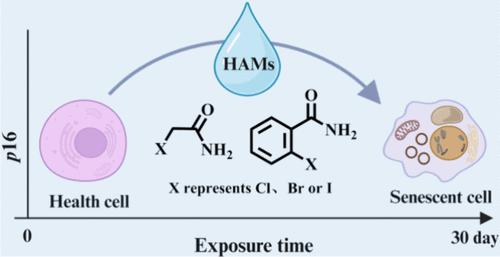长期暴露于环境水平的卤乙酰胺加剧细胞衰老:表型和机制的见解
IF 11.3
1区 环境科学与生态学
Q1 ENGINEERING, ENVIRONMENTAL
引用次数: 0
摘要
消毒副产物(DBPs),如卤代乙酰胺(HAMs),与包括膀胱癌在内的不良健康结果有关。dbp加剧细胞衰老的可能性,从而将暴露与健康影响联系起来,目前仍未得到充分探索。在这项研究中,MRC-5细胞暴露于浓度为2、5和8 μg/L的火腿中30天,以模拟长期暴露于饮用水中的水平。在蛋白组水平上,6种被测火腿均显著增加了细胞衰老程度,丰富了细胞衰老途径。具体来说,火腿上调microRNA-24的表达,增加p16 mRNA水平,降低p16蛋白水平,从而激活癌基因诱导的衰老途径。此外,研究发现HAMs与TNRC6A共价结合,激活p53/p21通路。主成分分析强调了功能基团在激活衰老中的关键作用,并且HAMs和TNRC6A之间的相互作用可以扩展到至少27个其他含酰胺的dbp。长期暴露于环境相关水平的火腿会显著加剧细胞衰老,从而揭示了一个通常被忽视的现象。鉴于饮用水中DBPs的广泛存在以及它们在人类中的持续暴露,它们在细胞衰老中的作用是一个持续的公共卫生问题。本文章由计算机程序翻译,如有差异,请以英文原文为准。

Prolonged Exposure to Environmental Levels of Haloacetamides Exacerbates Cellular Senescence: Phenotypic and Mechanistic Insights
Disinfection byproducts (DBPs), such as haloacetamides (HAMs), have been associated with adverse health outcomes, including bladder cancer. The potential for DBPs to exacerbate cellular senescence, thereby linking exposure to health impacts, remains underexplored. In this study, MRC-5 cells were exposed to HAMs at concentrations of 2, 5, and 8 μg/L for 30 days to simulate long-term exposure to levels found in drinking water. All six tested HAMs significantly increased the cellular senescence degree and enriched the cellular senescence pathway at the proteomic-wide level. Specifically, HAMs upregulated microRNA-24 expression, which increased p16 mRNA levels and decreased p16 protein levels, thereby activating oncogene-induced senescence pathways. Additionally, HAMs were found to covalently bind to TNRC6A, activating the p53/p21 pathway. Principal component analysis highlighted the critical role of functional groups in activating senescence, and the interaction between HAMs and TNRC6A could extend to at least 27 other amide-containing DBPs. Prolonged exposure to HAMs at environmentally relevant levels notably exacerbates cellular senescence, shedding light on a commonly overlooked phenomenon. Given the widespread presence of DBPs in drinking water and their continuous exposure in humans, their role in cellular senescence represents an ongoing public health concern.
求助全文
通过发布文献求助,成功后即可免费获取论文全文。
去求助
来源期刊

环境科学与技术
环境科学-工程:环境
CiteScore
17.50
自引率
9.60%
发文量
12359
审稿时长
2.8 months
期刊介绍:
Environmental Science & Technology (ES&T) is a co-sponsored academic and technical magazine by the Hubei Provincial Environmental Protection Bureau and the Hubei Provincial Academy of Environmental Sciences.
Environmental Science & Technology (ES&T) holds the status of Chinese core journals, scientific papers source journals of China, Chinese Science Citation Database source journals, and Chinese Academic Journal Comprehensive Evaluation Database source journals. This publication focuses on the academic field of environmental protection, featuring articles related to environmental protection and technical advancements.
 求助内容:
求助内容: 应助结果提醒方式:
应助结果提醒方式:


